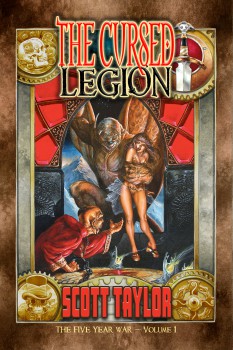Art of the Genre: Front Loading a Kickstarter

Ok, could Kickstarter be any more popular than it is right now? I’m thinking no… I mean, if we were looking at a bell curve, beginning in 2009 with Kickstarter’s launch, the top of the bell should be right here, right now.
As I was moving through Facebook yesterday, a place where until November 2011 I’d never heard or seen a mention of Kickstarter, I counted 9 different threads among sites I frequent either pushing a new Kickstarter or asking questions about the platform.
It’s kind of crazy, and yet when the gravy train is running, anyone out there would be a fool not to jump on board, or so all the property flippers from 2006 would like you to believe.
Still, I digress, as this post is about something other than the proliferation of the platform.
This fine Saturday, one in which I incredibly DON’T have a Kickstarter to peddle, I’m going to talk a bit about getting ready for a Kickstarter.
As I mentioned in my last post on the subject, a video is now an even greater key to a Kickstarter’s success, and the days of one-on-one testimonials are dying faster than the people of Portland in the TV show Grimm.
But before I reiterate my discussion on videos from two weeks ago, I really want to take you into the world of Kickstarters, fulfillment, and what it takes to not only get one going, but also how to wrap it up and get it out the door after all the ‘crazy’ ends. This process will take a couple of weeks, so bear with me, but it still begins today with the question I got earlier this week.
The question that inspired this post came to me on Wednesday, and it went something like this: ‘When you do a Kickstarter, how much of it is done before you begin?’
Good question; and one I can attempt to answer, but only from the standpoint of what I produce, which are books.
First, I’ll take you back to November 2011 again when I was first introduced to Kickstarter. During my initial viewing of the platform I was struck by two Kickstarters in particular. One, was Jeff Dee’s recreation of the Egyptian images from the Advanced Dungeons & Dragons Deities and Demigods sourcebook which I wrote my first Kickstarter blog about. The second was Laura Anne Gilman’s From Whence You Came: A Land’s Vin Novella, and that is the one I want to speak about in bulk today.

That Kickstarter was the basis for all my Kickstarters because it had two things I intended to include, a self-promoting writer, and a well known cover artist. True, Laura Anne is a well respected and published writer in her own right, but as I read through her proposal I couldn’t help but wonder at it.
Laura Anne was offering to do a novella, so roughly 20,000 words, and if she got enough backing she could expand it into a full novel of 40,000+ words, have interior illustration by Bob Eggleton [her cover artist] and so forth and so on.
Two things struck me about this project. The first was that it was a novella, which is perhaps twice the size of a lengthy short story in most markets and in my line of work should take no more than two weeks to produce. Now given, all writers are different, and I write fast, but still, I had to wonder how long it would take a seasoned vet like Laura Anne to crank out 20,000 words.
This brings me to point two about her Kickstarter, and that was a delivery date of April 2012. Now I know Bob Eggleton is a working artist, which means he should have at least two months booking into the future at any given time, but a four month window to deliver a novella with a cover seemed awfully lengthy.
To me, such a time frame says that the novella isn’t yet written and Bob is fully booked. Thus, a stretch goal of interior illustrations would swell the artist’s timeline [and she did get interior art funded]. That means, at least to me, that when this Kickstarter began, nothing for the project was in place or pre-created.
When I looked at my own Kickstarter, I wanted speed above all else, so I knew I needed to have a leg up if I was going to do the project at the pace I wanted it done. That meant that I would have to invest time and energy in the project without knowing that there would be any return on my investment. It was a risk I was willing to take, and one all participants in small budget Kickstarters will have to as well if they want quick delivery dates.
For my first Kickstater with Jeff Easley, which launched on January 16th 2012, I’d already completed the novel in rough form after preliminary discussions with Jeff about the project in early December 2011. The completion of this novel, at 50,000 words, took 26 days, so roughly a month’s worth of work with no guarantee of return on investment.
After watching Jeff Dee’s Kickstarter begin rolling, and seeing how he was producing art for the Kickstarter DURING the 30-day funding window, I knew I wasn’t alone in my thinking about pre-loading your rewards.

As Jeff Easley was also on board for a make-or-break scenario, he began working on his contribution art as the project launched which greatly helped matters. Although we were lucky enough to reach our funding goal in four days, we’d both already invested a great deal, so or pre-load worked in our favor, but it was still a hefty risk.
Even with proactive work, every project is going to have unforeseen delays, and I tried to look at what I’d already completed, what still needed to be done, and how things could be streamlined after the pledge campaign ended to keep things rolling.
For the Easley Kickstarter, which ended on the 18th of February, I set a delivery date of April 2012 and crossed my fingers. This was nearly a month and a half less time than Laura Anne and I’d included more interior art and twice the number of words. It was a risk, but again, speed was a primary motivator in building a fan base with great products as quickly as I could get them out.
Did I have delays? Oh for the love off all that is holy did I have delays! Frankly, I’m still having delays as we turn the corner on the 3rd week of April, but even with them I’m going to make the deadline. Truly, I had no idea all the things that could and would go wrong along the way, but each project helps prepare you for the next one, allows you to foresee pitfalls, build in stronger backer rewards, have more fun, and get to the meat of the platform and what it can accomplish.
Preparedness, however, is a key, and to me the more work you can have done BEFORE you launch, the better it will be for you in the long run, especially if art is involved.
Ok, so I hope that helps establish what you need to do before starting your Kickstarter, and I think next week I’m going to take you through what happens after the party is over, which is an even larger piece of the whole Kickstarter puzzle.
Before I leave, however, I wanted to post up a couple of small Kickstarters that I think might interest readers of my blog. The first is another one by Laura Anne Gilman who is looking to expand another of her memorable characters, this one from the urban fantasy series Cosa Nostradamus. Another interesting little Kickstarter is called Dice Chuckers and is a documentary about gamers, which I think sounds fantastic and I’d love to see it get the attention it deserves.
Until next time, remember that your support of Kickstarter is providing a kind of creative renaissance, so keep up looking at the platform because there is always a something noteworthy to find there.
If you like what you read in Art of the Genre and are interested in seeing both great artwork from Art of the Genre artists and our Kickstarter produced novels you can find them here or even come say hello to me on Facebook.
Very sorry to post an off-topic suggestion, but I was just wondering if you’ve considered writing an Art of the Genre piece about the current state of affairs regarding cover art for fantasy and science fiction novels. I see a lot of photo-manipulation covers and hybrid photo/3D/digital painted covers, and I feel that a lot of them actually look pretty cheap and nasty. If I was Howard Andrew Jones, for example, I would be very happy with the first Desert of Souls cover (100% digitally painted, stirring, full of life and movement, etc) and very unhappy with the second cover (a mish-mash of photo elements and, I don’t know? 3D elements? What’s going on with those faces? It almost looks like a romance novel cover.) What do you think about this trend?
Cephalophore: An odd question concerning the topic. I believe I’ll try to address it in my Wednesday post. I have information directly relating to this, but I’ll have to touch base with sources to post.